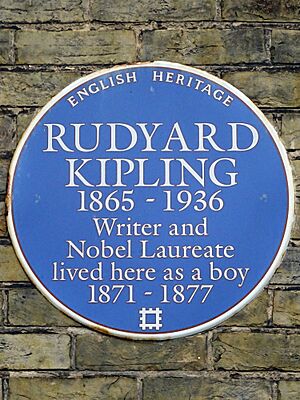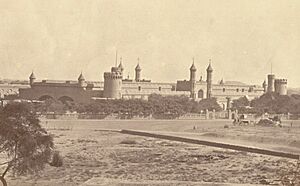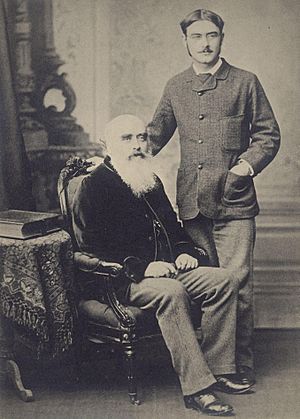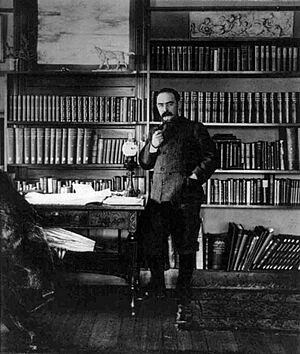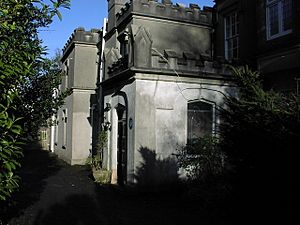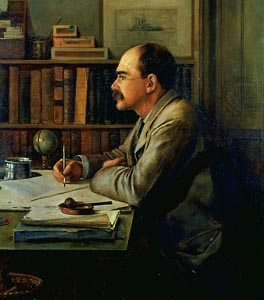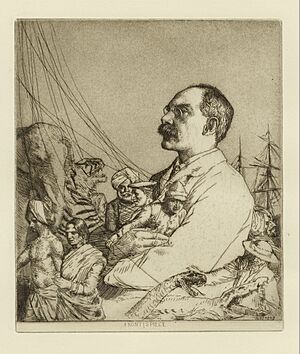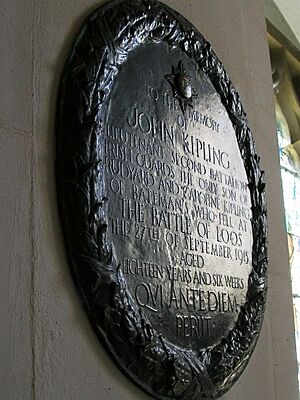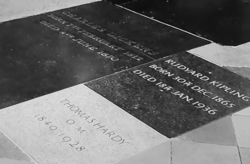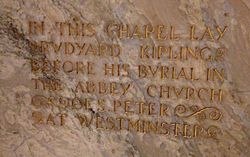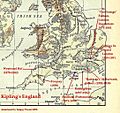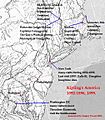Rudyard Kipling facts for kids
Quick facts for kids
Rudyard Kipling
|
|
|---|---|
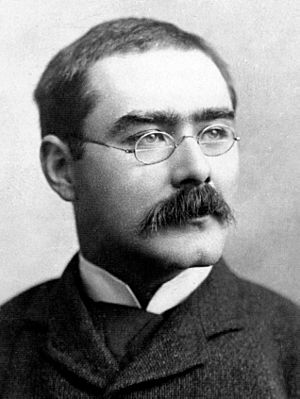
Kipling in 1895
|
|
| Born | Joseph Rudyard Kipling 30 December 1865 Malabar Hill, Bombay Presidency, British India |
| Died | 18 January 1936 (aged 70) Fitzrovia, London, England |
| Resting place | Poets' Corner, Westminster Abbey |
| Occupation |
|
| Genre |
|
| Notable works |
|
| Notable awards | Nobel Prize in Literature 1907 |
| Spouse |
Caroline Starr Balestier
(m. 1892) |
| Children | 3, including Elsie and John |
| Parents |
|
| Signature | |
Joseph Rudyard Kipling (born December 30, 1865 – died January 18, 1936) was an English writer. He wrote novels, short stories, poems, and worked as a journalist. He was born in British India, and his time there greatly inspired his writing.
Kipling wrote many famous books. These include The Jungle Book (1894), The Second Jungle Book (1895), Kim (1901), and the Just So Stories (1902). He also wrote many short stories, like "The Man Who Would Be King" (1888). His well-known poems include "Mandalay" (1890) and "If—" (1910). He was very good at writing short stories, and his children's books are still loved today.
In the late 1800s and early 1900s, Kipling was one of the most popular writers in the United Kingdom. In 1907, he won the Nobel Prize in Literature. He was the first English-language writer to receive this award and, at 41, the youngest person ever to win it at that time. He was also offered the title of British Poet Laureate and a knighthood several times, but he said no to both. After he died in 1936, his ashes were buried in Poets' Corner at Westminster Abbey.
Contents
Kipling's Early Life (1865–1882)
Rudyard Kipling was born on December 30, 1865, in Bombay, British India. His parents were Alice Kipling and John Lockwood Kipling. His mother, Alice, was a lively woman. His father, John Lockwood Kipling, was a sculptor and pottery designer. He was also the head of the Sir Jamsetjee Jeejebhoy School of Art in Bombay.
John Lockwood and Alice met in England near Rudyard Lake. They loved the area so much that they named their first child, Joseph Rudyard, after it. Two of Alice's sisters married famous artists, and another sister was the mother of Stanley Baldwin, who later became Prime Minister of the United Kingdom.
Kipling's birth home in Bombay was later used as the dean's house. Some people think the original house was replaced, but a plaque marks the spot near where he was born. Kipling remembered Bombay fondly, describing the sights and smells.
His parents were "Anglo-Indians," meaning they were British people living in India. Kipling also saw himself this way, even though he lived most of his life elsewhere. He remembered how his Indian nannies would tell him stories in local languages. Then, his parents would tell him to "Speak English now to Papa and Mamma." This showed the mix of cultures in his life.
School Days in Britain
When Kipling was five, he and his three-year-old sister, Alice (Trix), were sent to live in the United Kingdom. This was a common practice for British children in India. They lived with a couple, Captain and Mrs. Holloway, in Southsea, Portsmouth, for six years. Kipling called this time "the House of Desolation" because he was treated badly. He later wrote that this difficult time might have made him start writing earlier.
Trix had a better time at the Holloway's house. The Kipling children had no other relatives to visit in England, except for a month each Christmas. They spent this time with their aunt Georgiana and her husband, Edward Burne-Jones, in London. Kipling called this "a paradise which I verily believe saved me."
In 1877, his mother returned from India and took the children away from Lorne Lodge. Kipling later said that children often don't tell adults about bad treatment because they think it's normal or fear what might happen if they speak up.
After a happy summer on a farm, Kipling went to the United Services College in January 1878. This school prepared boys for the army. It was tough at first, but he made good friends there. This school became the setting for his stories in Stalky & Co. (1899). At school, he met Florence Garrard, who became the inspiration for a character in his first novel, The Light That Failed (1891).
Returning to India
Kipling did not get a scholarship to Oxford University, and his parents could not afford to send him. So, his father found him a job in Lahore, India. His father was the head of the Mayo College of Art and curator of the Lahore Museum. Kipling became an assistant editor for a local newspaper, the Civil and Military Gazette.
He sailed back to India in 1882, arriving in Bombay on October 18. He was almost 17 but looked older. He felt a strong connection to India, saying his "English years fell away."
Kipling's Early Adult Life (1882–1914)
From 1883 to 1889, Kipling worked for newspapers in British India, including the Civil and Military Gazette in Lahore and The Pioneer in Allahabad.

The Civil and Military Gazette was a busy newspaper, published six days a week. Kipling worked hard, but he loved to write. In 1886, he published his first collection of poems, Departmental Ditties. The new editor, Kay Robinson, gave Kipling more freedom to write short stories for the newspaper.
An old colleague once said Kipling loved ink so much that he would splash it everywhere, making him look like a Dalmatian dog covered in spots!
In the summer of 1883, Kipling visited Simla (now Shimla), a popular hill station and the summer capital of British India. The Viceroy of India and government would move there for six months. Kipling's family visited Simla every year, and he returned for his holidays from 1885 to 1888. Simla appeared in many of his stories. He loved his time there, saying it was "pure joy."
Back in Lahore, 39 of his stories were published in the Gazette between 1886 and 1887. Most of these were included in Plain Tales from the Hills, his first collection of prose, published in 1888. Kipling then moved to a larger newspaper, The Pioneer, in Allahabad, where he worked as an assistant editor.
Kipling wrote very quickly during this time. In 1888, he published six more collections of short stories, with a total of 41 stories. He also wrote many sketches for The Pioneer as a special reporter, which were later collected in From Sea to Sea and Other Sketches, Letters of Travel.
Kipling left The Pioneer in 1889 after a disagreement. He sold the rights to his story collections for a good amount of money. He decided to use this money to move to London, the center of the British Empire's literary world.
Moving to London
On March 9, 1889, Kipling left India. He traveled through San Francisco, Japan, and the United States. He was very impressed by Japan, calling its people "gracious folk." The Nobel Prize in Literature committee later mentioned Kipling's writings on Japanese customs when they gave him the award.
Kipling also wrote about falling in love with a geisha named O-Toyo in Japan. He then traveled across the United States, writing articles for The Pioneer about his journey.
During his trip, he met the famous American writer Mark Twain in Elmira, New York. Kipling was very impressed by Twain. He arrived at Twain's home without an appointment, but Twain welcomed him and they talked for two hours about literature. Twain gave Kipling advice: "get your facts first and then you can distort 'em as much as you please." Twain later joked that between them, they covered all knowledge.
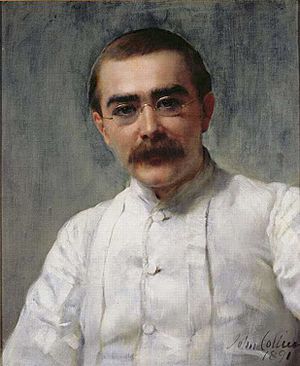
Kipling arrived in Liverpool in October 1889. He quickly became well-known in London's literary scene. Over the next two years, he published a novel, The Light That Failed. He also met an American writer and agent, Wolcott Balestier, and they worked together on a novel called The Naulahka. In 1891, Kipling took a sea trip to South Africa, Australia, New Zealand, and India for his health. He cut his trip short when he heard that Wolcott Balestier had died suddenly. Before returning to London, he proposed to Wolcott's sister, Caroline Starr Balestier (called "Carrie"), whom he had met earlier. She accepted.
On January 18, 1892, Carrie Balestier (29) and Rudyard Kipling (26) got married in London. The writer Henry James was at their wedding.
Life in the United States
Kipling and Carrie went on their honeymoon to the United States and Japan. In Japan, they found out their bank had failed, so they returned to the U.S. Carrie was pregnant, so they rented a small cottage near Brattleboro, Vermont. Kipling called it Bliss Cottage.
Their first child, Josephine, was born there on December 29, 1892. Kipling said she had a good sense of timing, as her mother's birthday was December 31 and his was December 30.
It was in Bliss Cottage that Kipling started writing The Jungle Books. He had written a story about a boy raised by wolves, and in the quiet winter, ideas came together. He began writing stories about Mowgli and the animals, which became the two Jungle Books.
As their family grew, Bliss Cottage felt too small. So, they bought land and built their own house, which Kipling named Naulakha. He named it after a beautiful building in Lahore Fort in India. The house is still there today in Dummerston, Vermont. Kipling called his house his "ship" and said it brought him "sunshine and a mind at ease." Living quietly in Vermont helped Kipling write many stories.
In just four years, he wrote the Jungle Books, a collection of short stories called The Day's Work, a novel called Captains Courageous, and many poems. He especially enjoyed writing the Jungle Books and getting letters from children about them.
Life in New England
Visitors sometimes interrupted Kipling's writing life at Naulakha, including his father and the British writer Arthur Conan Doyle. Doyle brought his golf clubs and taught Kipling how to play. Kipling enjoyed golf, even playing with red-painted balls in the snow!
Kipling loved the outdoors, especially the changing colors of the leaves in Vermont each autumn. He described the hillsides turning "afire, and the roads paved, with crimson and gold."
In February 1896, their second daughter, Elsie, was born. Later that year, Kipling taught for a short time at Bishop's College School in Quebec, Canada.
The Kiplings loved living in Vermont, but two things made them leave. First, there was a border dispute between the United Kingdom and Venezuela, which caused tension with the U.S. Kipling felt there was a lot of anti-British feeling in the U.S. press. By 1896, he decided to move his family back to England.
Second, there was a family problem. Relations between Carrie and her brother Beatty Balestier were difficult. In May 1896, Beatty threatened Kipling. This led to Beatty's arrest and a lot of public attention, which Kipling hated. In July 1896, the Kiplings packed up and returned to England.
Moving to Devon and Sussex
By September 1896, the Kiplings were in Torquay, Devon, on the coast of England. Kipling didn't love the house, but he kept writing and was active in society.
Kipling was now very famous and started sharing his political views in his writing. Their first son, John, was born in August 1897. Kipling wrote two poems, "Recessional" (1897) and "The White Man's Burden" (1899), which caused some debate. Some people saw them as celebrating the British Empire, while others saw them as supporting unfair ideas.
Kipling also wrote Stalky & Co., a collection of school stories based on his own school experiences. His family said he loved reading these stories aloud and would laugh at his own jokes.
Trips to South Africa
In early 1898, the Kiplings started a tradition of spending their winter holidays in South Africa. They stayed in a house called "The Woolsack" on Cecil Rhodes's estate.
Kipling was seen as the "Poet of the Empire" and was welcomed by important politicians in South Africa. He became friends with them and admired their ideas. This was an important time in South African history, including the Second Boer War (1899–1902). Back in England, Kipling wrote poems supporting the British in the war. On his next visit to South Africa in 1900, he worked as a reporter for The Friend newspaper, which was used by British troops.
Life in Sussex
In 1897, Kipling moved from Torquay to Rottingdean, near Brighton, East Sussex. In 1902, Kipling bought Bateman's, a house built in 1634, in rural Burwash.
Bateman's was Kipling's home from 1902 until he died in 1936. He bought the house and its land for £9,300. It didn't have modern bathrooms or electricity, but Kipling loved it. He called it "a good and peaceable place."
Kipling also wrote about important issues. He wrote articles about the rise of German naval power, which were collected in A Fleet in Being. In 1899, during a visit to the United States, Kipling and his daughter Josephine got pneumonia. Sadly, Josephine died at age 7.

After Josephine's death, Kipling focused on gathering material for Just So Stories for Little Children, published in 1902. This was the year after his famous novel Kim. Some experts say Kim shows Kipling's interest in Buddhism and doesn't support negative views of Eastern cultures. Kipling was also upset by the German Emperor Wilhelm II's "Hun speech" in 1900, where he told German troops to act like "Huns." Kipling later used the term "Hun" as an insult for Germans in his poem The Rowers.
Science Fiction Stories
Kipling wrote some early speculative fiction stories. These included "The Army of a Dream" and two science fiction stories: "With the Night Mail" (1905) and "As Easy As A.B.C." (1912). Both were set in the 21st century and featured his idea of an "Aerial Board of Control." These stories used a technique called indirect exposition, where information is revealed through the story rather than directly stated. Kipling learned this technique in India to help English readers understand Indian society in The Jungle Book.
Nobel Prize and Famous Poems
In 1907, Kipling won the Nobel Prize for Literature. The award recognized his "power of observation, originality of imagination, virility of ideas and remarkable talent for narration." He was the first English-language writer to win this prize.
After this, he published two more collections of stories and poems: Puck of Pook's Hill (1906) and Rewards and Fairies (1910). The second book included the poem "If—". In a 1995 BBC poll, "If—" was voted the UK's favorite poem. It's about self-control and staying strong, and it's probably Kipling's most famous poem.
Kipling was so popular that he was asked to help in the 1911 Canadian federal election. He wrote an article against a trade treaty with the United States, saying Canada risked losing its unique identity. This article was printed in many Canadian newspapers and is thought to have helped turn public opinion against the treaty.
Kipling also supported Irish Unionists, who wanted Ireland to remain part of the United Kingdom. He wrote the poem "Ulster" in 1912, showing his views. He saw Irish independence as a betrayal.
Kipling was strongly against Bolshevism (early communism), a view he shared with his friend H. Rider Haggard.
Freemasonry
Kipling became a Freemason in Lahore around 1885, even before he was 21. He wrote about his lodge, saying it included members from different religions. He loved his Masonic experience and wrote about its ideas in his poem "The Mother Lodge." He also used the group and its symbols in his story The Man Who Would Be King.
First World War (1914–1918)
When the First World War began, Kipling, like many writers, wrote articles and poems supporting Britain's war goals. He accepted the government's request to write propaganda. His writings were popular, focusing on the bravery of British soldiers and the suffering caused by Germany.
Kipling was very against Germany. However, he was also privately critical of how the British Army was fighting the war. He felt that earlier British leaders had not prepared the army well enough, leading to many deaths.
In 1914, Kipling was one of 53 leading British authors who signed a statement. It said that Germany's invasion of Belgium was a crime and that Britain had to join the war.
The Death of John Kipling
Kipling's son, John, was killed in action at the Battle of Loos in September 1915, when he was 18. John wanted to join the Royal Navy, but his poor eyesight prevented him. He tried twice to join the army but was rejected for the same reason. However, Kipling was friends with Lord Roberts, a former army commander. At Kipling's request, John was accepted into the Irish Guards.
John Kipling was sent to the battle two days after it started. He was last seen struggling through mud with a possible face injury. A body believed to be his was found in 1992, and in 2015, the Commonwealth War Graves Commission confirmed his burial place.
After his son's death, Kipling wrote a poem called "Epitaphs of the War," which included the line "If any question why we died / Tell them, because our fathers lied." Some think this shows Kipling's guilt about helping John join the army. Others believe it refers to Kipling's anger that British leaders were unprepared for the war.
John's death is often linked to Kipling's 1916 poem "My Boy Jack." However, the poem was originally about a death at sea, and "Jack" might refer to a generic sailor. Still, Kipling was heartbroken by his son's death. He found comfort by reading Jane Austen's novels aloud to his wife and daughter. During the war, he also wrote a booklet about naval subjects.
Kipling became friends with a French soldier whose life was saved when a copy of Kim in his pocket stopped a bullet. The soldier gave Kipling the book and his medal as thanks.
After the War (1918–1936)

After John's death, Kipling joined the Imperial War Graves Commission (now the Commonwealth War Graves Commission). This group is responsible for the British war graves around the world. Kipling helped choose the famous phrase, "Their Name Liveth For Evermore," found on large war memorials. He also suggested "Known unto God" for the graves of unknown soldiers. He chose "The Glorious Dead" for the Cenotaph in London. He also wrote a two-volume history of the Irish Guards, his son's regiment.
Kipling also became a motoring reporter, writing about trips around England and abroad. He was usually driven by a chauffeur.
After the war, Kipling was unsure about the League of Nations. He hoped the United States would join other countries to keep world peace. He was sad when Theodore Roosevelt died in 1919, believing he was the only American leader who could keep the U.S. involved in world politics.
Kipling was very against communism. He wrote that after the October Revolution in 1917, Russia had "passed bodily out of civilization."
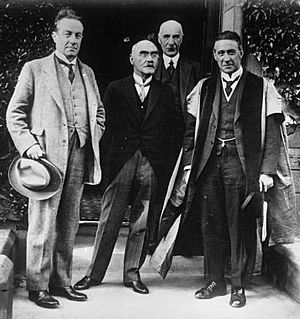
In 1922, Kipling helped create a special ceremony and obligation for engineering students at the University of Toronto. This became "The Ritual of the Calling of an Engineer," where Canadian engineering graduates receive an iron ring to remind them of their duty to society. In 1922, Kipling also became Lord Rector of St Andrews University in Scotland for three years.
Kipling was a big fan of France and strongly supported an alliance between Britain and France to maintain peace. He called them the "twin fortresses of European civilization." He also warned against changing the Treaty of Versailles in Germany's favor, predicting it would lead to another world war.

Kipling's political views were generally conservative. While he admired Benito Mussolini somewhat in the 1920s, he was against fascism. By 1935, he called Mussolini a "deranged and dangerous egomaniac" and wrote in 1933, "The Hitlerites are out for blood."
Even though Kipling was anti-communist, his books were translated into Russian and were popular in the Soviet Union in the 1920s. Many young Russian writers were influenced by his clear style and use of everyday language. His works were not banned in the Soviet Union until 1939.

Many older editions of Kipling's books have a swastika on the cover. This was an Indian symbol of good luck, meaning "fortunate" or "well-being." Kipling used it because of Indian culture. However, once the swastika became linked to Adolf Hitler and the Nazis, Kipling ordered that it should no longer be on his books. Less than a year before he died, Kipling gave a speech warning about the danger of Nazi Germany.
Kipling wrote the first Royal Christmas Message, delivered by King George V on the BBC in 1932.
Death
Kipling continued writing into the early 1930s, but less often. On January 12, 1936, he became very ill. He had surgery but died less than a week later, on January 18, 1936, at age 70, from a stomach ulcer. His body rested at the Fitzrovia Chapel before his funeral.
His death had been wrongly announced in a magazine before. Kipling joked about it, writing, "I've just read that I am dead. Don't forget to delete me from your list of subscribers."
At his funeral, his cousin, Prime Minister Stanley Baldwin, was one of the people who carried his coffin. Kipling was cremated, and his ashes were buried in Poets' Corner at Westminster Abbey, next to Charles Dickens and Thomas Hardy.
Kipling's Legacy
Kipling's writing has had a big impact on many other writers. His stories for adults are still printed and praised by authors like Jorge Luis Borges. His children's stories are still very popular, and The Jungle Books have been made into several films, including by The Walt Disney Company. Some of his poems were set to music.
The poet T. S. Eliot edited a collection of Kipling's poems. Eliot disagreed with people who criticized Kipling for his political views, saying he could not find "any justification for the charge that he held a doctrine of race superiority." Eliot called Kipling a "great verse writer."
George Orwell also wrote about Kipling, saying that even though some saw him as an "imperialist," his work had qualities that made it last.
The English folk singer Peter Bellamy loved Kipling's poetry and recorded albums of his poems set to music.
Kipling's words are still used in discussions about British issues today. In 1996, former Prime Minister Margaret Thatcher quoted Kipling's poem "The Reeds of Runnymede" to warn against the influence of the European Union.
Links with Camping and Scouting
In 1903, Kipling allowed Elizabeth Ford Holt to use themes from The Jungle Books to start Camp Mowglis, a summer camp for boys in New Hampshire. Kipling and his wife stayed interested in the camp, which still uses traditions inspired by his stories. Buildings at the camp are named after characters like Akela and Baloo.
Kipling also had strong links with the Scouting movement. Robert Baden-Powell, who founded Scouting, used many ideas from The Jungle Book and Kim for his junior Wolf Cubs. This connection continues today, with activities like "Kim's Game" and adult leaders of Cub Scout Packs taking names from The Jungle Book.
Kipling's Home in Burwash
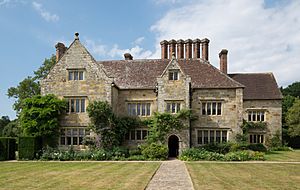
After Kipling's wife died in 1939, their house, Bateman's in Burwash, East Sussex, was given to the National Trust. It is now a public museum about the author. His only child who lived to adulthood, Elsie Bambridge, died without children in 1976. She gave her copyrights to the National Trust, which then gave them to the University of Sussex for public access.
In 2003, actor Ralph Fiennes read parts of Kipling's works from Bateman's for a CD published by the National Trust.
Kipling's Reputation in India
In modern-day India, where Kipling got much of his inspiration, his reputation is still debated. Some people criticize him, especially modern nationalists and post-colonial critics. It was once thought that Kipling strongly supported Colonel Reginald Dyer, who was responsible for the Jallianwala Bagh massacre. However, historians say that while Kipling did donate a small amount of money, he did not call Dyer "the man who saved India" or organize a fund for him.
Many Indian thinkers today have mixed views of Kipling. Jawaharlal Nehru, India's first prime minister, often said Kipling's novel Kim was one of his favorite books.
Indian writer Khushwant Singh wrote in 2001 that Kipling's "If—" poem was like "the essence of the message of The Gita in English," referring to an ancient Indian scripture. Another Indian writer, R. K. Narayan, said Kipling understood animals in the jungle better than people in an Indian home.
In November 2007, it was announced that Kipling's birth home in Bombay would be turned into a museum celebrating him and his works.
Screen Portrayals
- Reginald Sheffield played Kipling in Gunga Din (1939).
- Christopher Plummer played Kipling in The Man Who Would Be King (1975).
- David Haig played Kipling in My Boy Jack (2007).
Images for kids
-
Map of places visited by Kipling in British India.
See also
 In Spanish: Rudyard Kipling para niños
In Spanish: Rudyard Kipling para niños
- Kipling Trail
- List of Nobel laureates in Literature
- HMS Birkenhead (1845) – ship mentioned in one of Kipling's poems



